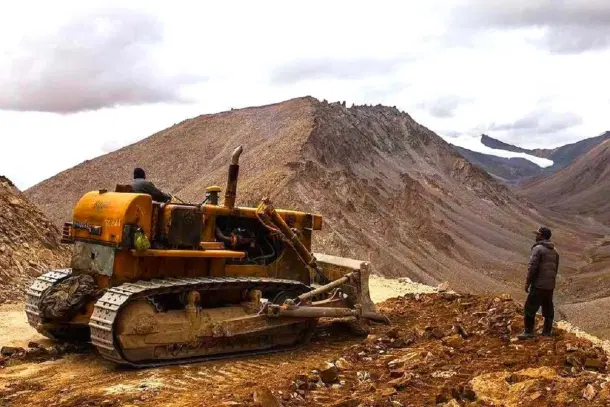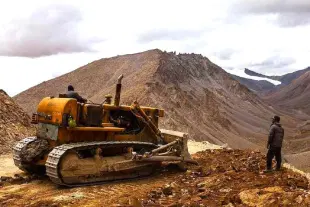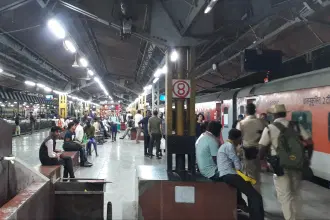Defence
China Alarmed At India’s Rapid Border Road Upgrades In Ladakh: Report
Swarajya Staff
Aug 11, 2025, 12:02 PM | Updated 12:02 PM IST
Save & read from anywhere!
Bookmark stories for easy access on any device or the Swarajya app.


India’s rapid upgrade of strategic border roads in Ladakh is raising alarms in Beijing as it narrows China’s long-standing infrastructure advantage along the sensitive Himalayan frontier, a report in South China Morning Post says.
India is carrying out major improvements to the Darbuk-Shyok-Daulat Beg Oldie (DSDBO) Road, its only land link to the Galwan Valley. Completed in 2019, the road is now being upgraded to handle tanks and specialised trucks capable of carrying long-range missiles, enhancing India’s military mobility in the region.
At the same time, India is constructing a 130-kilometre alternative route west of the DSDBO Road, nearing completion. Indian media reports say the new road is designed to reduce reliance on the existing route and stay out of sight of Chinese patrols, providing a tactical advantage in the contested border zone.
China claims the entire Galwan Valley, a claim rejected by India. The two sides remain divided by the Line of Actual Control (LAC), a contested boundary that saw a deadly clash in 2020, leaving at least 20 Indian and four Chinese soldiers dead.
Chinese experts have voiced strong concerns over India’s accelerated infrastructure push. He Xianqing, associate researcher at the National Institute for South China Sea Studies, said, “India’s border infrastructure … deserves close attention. It has substantially improved logistics and military capabilities in border areas. Its enhanced infrastructure capabilities may lead to risky provocations in border areas.”
He further pointed out that India’s recent incidents near the border were closely tied to infrastructure development, adding, “Since Modi took office … all of these incidents were related to infrastructure construction, and occurred in areas of India with relatively good infrastructure conditions.”
He cautioned that China should not simply react by building faster, but “develop its infrastructure at its own pace,” focusing on “promoting developmental infrastructure and new types of infrastructure, such as networks, electromagnetic systems, drone landing platforms and border situational awareness platforms.”
Lin Minwang, vice-dean at Fudan University’s Institute of International Studies, described India’s rapid construction as “a manifestation” of unprecedented border infrastructure competition between the two countries, particularly under Prime Minister Narendra Modi’s leadership. “Currently, both China and India are strengthening their control near the border,” he said, adding that India was taking “unprecedented measures” in this regard.
Despite China’s superior infrastructure in Tibet’s flat terrain—including the advanced G219 highway and Sichuan-Tibet Railway networks—the gap is shrinking. India’s mountainous terrain has traditionally hampered troop movement and logistics, but recent road projects aim to address this.
Amit Ranjan, research fellow at the National University of Singapore, said India’s main objective was clear: “to ease and speed up the movement of troops on the border region in case any emergency situation [confrontation with China] occurs.”
China has also been investing heavily in border surveillance and smart defence in Tibet since the 2020 clash. New intelligent monitoring towers equipped with thermal imaging and night vision have been deployed in border villages to enhance situational awareness—an area where India lags behind.
“China should focus on promoting … border situational awareness platforms,” He Xianqing said, underscoring the importance of technology alongside traditional infrastructure.
Though infrastructure competition continues, recent diplomatic efforts suggest a cautious attempt to stabilise ties. Last year, India and China signed a border patrol agreement aimed at restoring the pre-2020 status quo. Indian Prime Minister Narendra Modi is expected to visit China later this month for the Shanghai Cooperation Organisation summit—the first visit in seven years.
Still, analysts warn that the accelerated road-building and infrastructure upgrades remain a sensitive flashpoint. Lin said, “If India seeks to compete in border infrastructure development, China still holds a significant advantage,” but the gap is closing fast, potentially increasing tensions.
He Xianqing added, “The China-India reconciliation process is still in its early stages, and both sides need to rebuild mutual trust,” a reminder that infrastructure alone cannot resolve deep-rooted territorial disputes.





